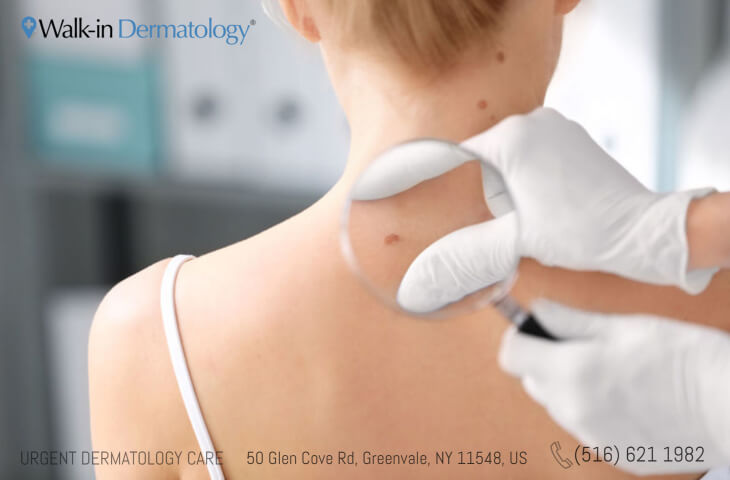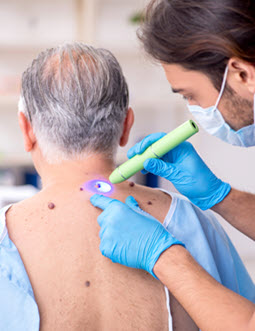Schedule a comprehensive skin cancer check to ensure early diagnosis regarding your skin health.
Schedule a comprehensive skin cancer check to ensure early diagnosis regarding your skin health.
Blog Article
Extensive Dermatology Expertise: Dealing With Acne Issues, Mole Issues, and Dermatitis Effects
When it involves skin health and wellness, detailed dermatology understanding is essential; it encourages people to take on common skin problems such as acne, mole irregularities, and dermatitis with self-confidence. Understanding acne treatments, recognizing potential skin cancer cells signs in moles, and handling eczema triggers can substantially improve skin health - skin cancer check. This article will check out these topics, using an informative explore the scientific research behind these typical skin concerns - an expedition that assures to enlighten and inform
Recognizing the Essentials: What Is Acne, Moles, and Eczema?
While lots of people might know with the terms acne, moles, and dermatitis, comprehending what they really are is a various matter entirely. Acne is a skin condition characterized by swollen or contaminated oil glands, frequently noticeable as pimples or areas, mainly on the face, back, and upper body. Moles, on the various other hand, are tiny skin developments triggered by clusters of pigmented cells; they can show up anywhere on the body and differ in color and size. Eczema, also known as atopic dermatitis, is a persistent problem creating inflamed, itchy skin, typically taking place in reaction to irritants or irritants. While these problems prevail, they can have varying levels of extent and effect on an individual's life.
The Scientific research Behind Acne: Reasons, Types, and Therapies
The complex scientific research behind acne begins with recognizing its formation device. This complex process, affected by various elements, causes different sorts of acne. The write-up will certainly also touch upon reliable treatments readily available to handle and treat this common skin condition.
Acne Formation Mechanism
An overwhelming majority of individuals will experience the common skin disease recognized as acne at some time in their lives. Acne development starts with the overproduction of sebum, an oily compound produced by sebaceous glands in the skin. This excess sebum, together with dead skin cells, blocks the skin's pores. When these blocked pores come to be infected with Propionibacterium acnes, a bacterium naturally existing on the skin, swelling takes place, resulting in noticeable acne. There are different sorts of acne, consisting of blackheads and whiteheads (non-inflammatory), and papules, pustules, blemishes, and cysts (inflammatory) Hormone modifications, particularly throughout the age of puberty or menstrual cycle, can worsen acne by activating boosted sebum production. Comprehending this mechanism is crucial for creating effective treatments, a subject to be reviewed later. eczema specialist.

Reliable Acne Therapies
Virtually every person will certainly face acne at some point, making a clear understanding of effective acne treatments important. Various treatments target different elements of acne, such as swelling, oil production, and bacteria. Topical therapies like benzoyl peroxide and salicylic acid can get rid of microorganisms and unblock pores. Antibiotics can combat swelling and germs. For serious situations, isotretinoin, a potent medication, can lower oil production. Non-drug therapies include light therapy and chemical peels. It's important to keep in mind that not all therapies will certainly benefit every person, as acne's causes and seriousness vary. Consequently, dermatologists commonly customize therapies to specific needs. Constant use of the picked treatment and perseverance are key to seeing improvement.
Mole Issues: Recognition, Examination, and When to Seek Medical Interest
Moles, usual skin developments, require mindful identification and normal examination for optimum skin health and wellness (skin cancer check). Identifying the normal appearance of one's moles, along with any kind of changes that might happen, is critical. Prompt clinical focus needs to be looked for when specific indicators, which will be reviewed, are identified
Recognizing Mole Recognition
How does one distinguish in between a safe mole and one that may require clinical attention? Initially, understanding the characteristics of typical moles is essential. A regular mole is typically round or oblong, has a smooth side, and is no larger than 6mm in diameter. The color ought to correspond top article and can vary from pink, tan, brownish, or black. Moles typically appear throughout childhood or adolescence, and by the adult years, most individuals have between 10 to 40 moles. Moles that alter in dimension, shape, or shade, become scratchy or bleed, or show up after age 30 can be startling. These abnormalities don't immediately suggest skin cancer yet are reasons to seek advice from a skin specialist. Recognizing mole recognition is the initial step in skin wellness administration.
Performing Normal Mole Exams

Acknowledging Important Clinical Indicators
When should one seek medical interest concerning moles? It is important to speak with a skin specialist once unusual attributes are discovered. These may consist of asymmetry, uneven borders, differing colors, a diameter bigger than 6mm, or developing size, shape, or shade. Referred to as the ABCDE's of mole evaluation, these adjustments may direct to deadly melanoma, a fatal kind of skin cancer. Additionally, any kind of blood loss, itching, or non-healing sores connected Read Full Report with moles necessitate prompt clinical attention. A person should additionally be cautious if brand-new moles appear after the age of 30 or if there's a sudden increase in the variety of moles. Regular self-examinations coupled with specialist analyses guarantee very early discovery and reliable treatment of potential skin irregularities.
Eczema Explained: Causes, Signs, and Managing Flare-Ups
Although eczema may look like an easy skin inflammation to the inexperienced eye, it is, in truth, an intricate dermatological problem with a plethora of potential causes. Eczema, also referred to as atopic dermatitis, is normally triggered by a combination of genetic and environmental aspects. Signs and symptoms can vary from moderate dry skin and itching to extreme breakouts and swelling. Triggers may vary between individuals, however typical ones include irritants, irritants, and stress and anxiety. Taking care of dermatitis normally involves determining and preventing triggers, maintaining a great skin treatment routine, and using suggested therapies. Due to the persistent nature of dermatitis, flare-ups may still take place even with cautious management. The secret is to resolve these flare-ups without delay to prevent aggravating symptoms.
Practical Skin Care Tips to stop and Handle Acne, Moles, and Dermatitis
Understanding and dealing with skin problem such as acne, moles, and dermatitis call for practical and efficient skin care practices. Regular cleaning with gentle, non-irritating items assists keep skin health and prevent acne. Sun block application reduces mole threat and reduces dermatitis flares caused by sunlight direct exposure. Moisturizing, particularly for those with eczema, is essential to preserve skin hydration and barrier function. A well balanced diet abundant in antioxidants can improve skin health and lower swelling, potentially reducing acne and dermatitis intensity. Routine skin checks assist in very early mole detection, potentially preventing skin cancer cells. While these ideas can mitigate skin troubles, they're not a substitute for expert skin-related guidance. Always get in touch with a dermatologist for relentless or severe skin problems.
Expert Dermatology Treatments: A Review of Modern Solutions
What are the modern solutions provided by professional dermatology therapies? Skin doctors today have a vast selection of efficient treatment alternatives to handle different skin conditions. For acne, retinoids and prescription antibiotics are prescribed to manage the condition, while chemical peels and laser therapy are utilized for severe cases. With moles, specialist removal is performed if they posture a health danger. This can be done through medical excision or laser elimination. On the other hand, dermatitis is usually treated with topical corticosteroids to take care of signs and symptoms, and phototherapy for consistent instances. Additionally, innovations in biologics have actually revealed guarantee in treating serious dermatitis. All these therapies are under the specialist advice and care of skin specialists, making certain secure and effective management of skin conditions.
Conclusion
Acne monitoring requires expertise of numerous treatment choices, while mole assessment can lead to early detection of skin cancers. Extensive dermatology knowledge is crucial for protecting against and handling these skin conditions, highlighting the requirement for expert dermatologist care to boost skin wellness.
Report this page